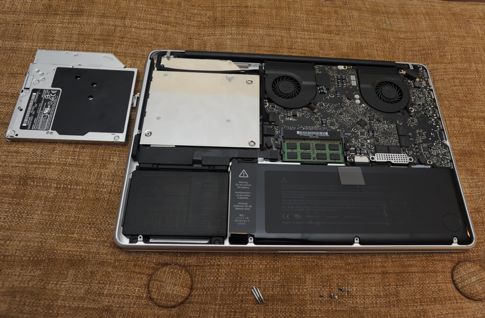Time to ditch the optical drive, once and for all

Once heralded as the second coming of data storage, the sun has finally set on the optical drive as an effective vehicle for data storage and delivery. Optical drives are simply too small and too slow to be practical. Single layer discs hold 4.7GB while double layer discs can hold 5.4GB.
Blu-Ray has more capacity, but its 25GB (single layer) and 50GB (double layer) doesn't hold a candle to the capacity of even a medium-size hard drive, let alone the 500GB monsters that have dropped as low as $100.
Apple hasn't released a Mac with a Blu-Ray drive, nor does Apple have support for Blu-Ray baked into Mac OS X. So even if you attach an external Blu-Ray drive to your Mac, you can only use if for reading and writing. You can't play a BD movie, for example, on Mac OS X unless you install a virtual copy of Windows. If Apple released Blu-Ray drives in Macs tomorrow, a case could be made for keeping optical drives in MacBooks a little longer -- for watching movies on a plane, for example.
At best the venerable optical drive is showing signs of age, at worst, it has one foot in the grave.
Apple needs to bury the optical drive next to the floppy drive, which Steve Jobs summarily killed with the announcement of the original bondi blue iMac in 1998. The future is to replace optical drive with flash media and downloads.
Snow Leopard should have been distributed on a flash drive and via BitTorrent.
I decided to take a leap of faith and installed an OptiBay hard drive (pictured above) from MCE Technologies in my MacBook Pro (late 2009) in place of the optical drive. Prices range from $189 for 250GB to $279 for a 7200RPM 500GB and the installation itself was easy. Just remove the bottom case, remove three screws, the optical drive and put the OptiBay in its place. Having a second hard drive in my MBP gives me gratuitous amounts of storage in place of an optical drive I barely used. From the OptiBay product page:
Now you can have unheard of capacities in laptop disk storage and space for everything you need to store... digital video, music, photos, etc. Two bootable hard drives inside your system provide a freedom and flexibility never before experienced in a Mac laptop... have one disk a scratch disk and the other your system/applications disk, RAID configurations, one disk Mac and the other PC, extra photo storage for digital photographers, extra music storage for digital DJ's, and more.
If you're worried about losing your optical drive, fear not. MCE includes an external optical drive enclosure for your removed SuperDrive so that you'll still be able to load software and read and write CD/DVD discs to your heart's content. Just pop your old optical drive into the enclosure, install two screws and you have a USB powered external SuperDrive. I'm keeping mine in my backback for a while, just in case.
Immediately after formatting the OptiBay 500GB HDD (a speedy Seagate Momentus 7200.4 mechanism) the first thing I did was move my music (100GB) and photo (30GB) libraries to my new found storage. Next I moved a 40GB VMWare virtual machine to the second hard drive for a combined savings of about 170GB. Whew! My SSD finally has some breathing room and I don't have to constantly use Disk Inventory X to save space.
For people used to large mobile hard drives, a second HDD may not exactly be compelling. However, if you've made the jump to using an SSD as your boot drive, a second hard drive in place of the optical drive is a practically a necessity. SSDs can instantly double the performance of your Mac but they cost significantly more than HDDs. The great news is you don't have to sacrifice capacity in exchange for raw speed. You can have the best of both worlds with an SSD and an OptiBay HDD installed in your MacBook Pro.
[poll="189"]
